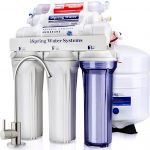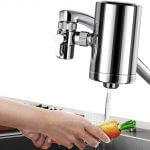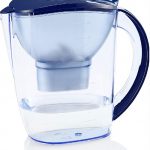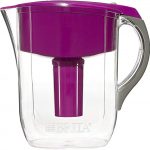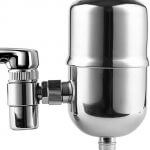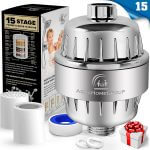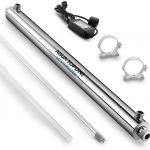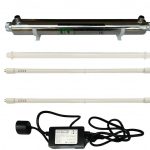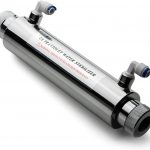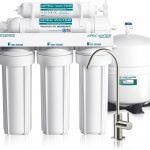Your tap water may not be safe enough for drinking as it is known to harbor an unhealthy level of pollutants and contaminants. The likes of lead, bacteria, pesticides, and heavy metal are replete in taps, well water supplies, and even in the metropolitan area. The initial step in ensuring a healthy life for you and your family is to find out the type of pollutants you have in your water and device means of eliminating them through the installation of an effective water purification system, which will guarantee a healthier life. Our helpful guide below will ensure that you are fully aware of the importance of filtering water and the types of water filters available.
Home Water Filters Comparison Table
Types of Water Filter
Water Filter Pitcher
Our top picks:
Because of their affordability and simplicity, water filter pitchers have become the most popular water filters among homes. Apart from requiring no setup, this kind of water filtration system is also portable; right at the top of this pitcher is a reservoir where you are expected to pour in the water.
Once the water goes in, it leverages gravity to flow through the pitcher’s filter cartridge. The kind of cartridge to expect in these inexpensive pitchers is the simple activated sort of carbon filter. However, those cartridges that come a bit more expensive make use of multiple types of silver and filter in providing a higher-quality filtration.
The downside with this type of filter is that its capacity is limited, and it takes longer for water to permeate the filter and pass through.
Reverse Osmosis
Our top picks:
The process of reverse osmosis involves using pressure in forcing impure water to pass through a membrane. As the water flows through, impurities and contaminants are left behind. In further explanation, osmosis is the process of separating a concentrated solution from another solution that is less concentrated with the aid of a semi-permeable membrane. Here, the membrane is the type that retains some substances while allowing others to pass through. By so doing, the solution tends to undergo some sort of rearrangement so that both are kept at that same concentration.
An illustration will help us to better understand the process – a sealed breakable bottle containing very sugary water is placed inside a glass jug filled with less sugary water. Nothing is expected to happen in this case. However, if your bottle happens to be a porous plastic that permits the passage of water, but not the sugar, you will observe that some of the water in the jug will start moving into the bottle through the plastic. This continues until the sugar on either side comes to the same level. So, the water moving to the bottle was achieved under pressure, and to put it more precisely, osmotic pressure.
With osmosis explained, what about reversed osmosis. For example, taking impure water and forcing it to go through any membrane under pressure in a bid to purify it only means that you are actually forcing the water to move in the opposite route to which it is expected to travel when exposed to regular osmosis. In further explanation, reverse osmosis water moves from a more concentrated or intense solution to a lesser concentrated solution.
Since the process in use is the reverse type where water is expected to go through the opposite direction as against its natural flow, impure water will permeate the membrane under pressure with extra energy. This is exactly the point at which electric power pumps come to play. While reverse osmosis is effective in eliminating pollutants such as salt, limescale, and nitrates, it is incapable of completely removing other contaminants like bacteria.
Reverse osmosis water filtration systems come with a good number of benefits. It is adept at filtering the majority of pollutants and water impurities. It eliminates or reduces iron, dissolved solids, lead, calcium, mercury, cysts, and bacteria, to a significant extent. A home that is equipped with this kind of water filter will always have the cleanest and purest drinking water. The RO membrane can last long, like two years or three.
Faucet Water Filter
Our top picks:
The name of this water filter implies that it can fit onto a faucet, purifying the water as it flows through its filter. In the same way as the pitcher filter, faucet water filter ranges from the fundamental carbon filters to those filters that are more advanced with multi-functions. You can get both your cooking and drinking water from the faucet directly.
With respect to cost, this kind of filter is relatively cheap. The installation is not complicated at all; however, it may not fit with every type of faucet. In addition, the filter is known to reduce the water pressure in households with low-pressure water supply – this may turn out to be problematic. Important to note that you can easily remove them whenever you wish to relocate.
Water Distillation
Our top picks:
Among the most common and easiest ways that water can be purified is by boiling. However, the heat is incapable of destroying certain chemicals, contaminants, and limescale, but it is effective at eliminating some dissolved solids such as asbestos fibers, salt, a few organic chemicals, particles, and minerals. Distinct from ordinary boiling, water distillation process takes purification to a higher level – while the water boils, the steam is captured and condenses into a different container.
When you consider the fact that water would naturally boil at a temperature lower than the metal contaminants, you will understand that these metals will be left behind as the steam percolates. Important to note that we still have some contaminants that are likely to boil at a lower temperature compared to water. What this means is that these impurities will evaporate alongside the steam – thus, distillation cannot be totally effective at eliminating such contaminants.
Reports from WHO stated that distilled water causes increased dieresis as well as loss of electrolytes in our body, thereby leading to dehydration. Recommendations for those drinking distilled water is that they need to supplement their water intake with essential minerals like magnesium, potassium, and calcium.
You can also couple your distillation with a carbon filter, which is sure to eliminate all forms of bacteria and chemical pollutants. The downside is that you need to fill it manually, and it makes use of a significant amount of electricity to function. Besides, it can be very slow, producing just a gallon of water after many hours.
The disadvantages notwithstanding, water distillation also comes with some benefits. Apart from eliminating the majority of impurities in water, it has strong water purification, and you don’t need to replace any filter cartridge.
Shower Water Filter
Our top picks:
This is comparable to a typical faucet water filter, as you can easily get them installed on a showerhead. Shower water filters come quite cheap, providing homes with basic filtration since they can eliminate chemicals such as fluoride and chlorine. These are the chemicals responsible for both dry skin and skin irritation. The benefits and downsides are similar to that of faucet water filters – it can be removed easily and lessens water pressure.
Countertop Water Filters
Our top picks:
Relative to pitcher water filters and faucet, countertop water filters are a bit more costly. However, they come way cheaper than your under sink water filters or whole house water filter, but they still achieve the same level of water filtration with the aid of a multi-stage RO filter.
The cons of using this type of filter are that it occupies counter space and comes with limited capacity relative to large storage tanks that are used under sink as well as whole-house filtration. The benefit is that installation and removal are quite easy.
Whole House Water Filters
Our top picks:
This kind of filter comes in the form of a huge RO filtration system connected to the major water supply in a home. In essence, all the available water outlets will have a supply of purified water. This system is more beneficial in homes where water contaminants such as calcium clog iron or pipes, leading to water discoloration that may cause stains on bathtubs, sinks, and the water closet.
You can install your whole house water filter in your garage or at any location outside the house. One disadvantage that may off-put potential users is that installation is rather complicated, and the cost is also high for both purchase and installation. Some of the filters can cause a drastic increase in water consumption since they tend to dump wastewater whenever it is used.
Ultra Violet (UV) filters
Our top picks:
This is a water purification technique that makes use of ultraviolet rays of light. Here, both pollutants and bacteria can be killed by allowing the UV light to pass on the water. The light attacks DNA in cells. More interesting is the fact that ultraviolet light is capable of killing nearly 99% of pesticides, which makes the technique highly effective. However, ultraviolet filters fail at eliminating suspended particles, color, and taste. It has a high capacity with purification, with a record over 2000 liters daily. Its major benefit is that it sterilizes water by killing viruses, pathogenic bacteria, and cysts. It is best for underground water or rainwater that may have had contact with waste from animals.
Under Sink Water Filters
Our top picks:
This comes in the form of reverse osmosis water filter with their installation done on a cabinet right under the kitchen sink. Some of them are quite basic, but we still have sophisticated ones like multi-stage RO systems. The good side of this kind of water purification system is that it is conveniently concealed and thus won’t mar the general aesthetics of any kitchen. However, it will occupy a reasonable amount of your cabinet space.
The function of the under sink filters is supplying water to a faucet that is already in existence. It can get water to multiple outlets very close to the sink. It is not strange to see this kind of filter installed using a separate faucet. The downside here is the system’s usage of a pump, which is usually noisy, and the installation may call for some drilling through the kitchen countertop. You can DIY your own installation as the kit comes with explicit instructions.
The list for water purification systems is not an exhaustive one as there are still many like ceramic filters, Biosand filters, and oxidation/reduction. We cannot fail to also mention the ion exchange, which is used for water softening.
Activated Carbon
This is among the most widespread water filters found in homes. These activated carbon granules are also known as active carbon-based on charcoal. Charcoal is one form of carbon that is extremely porous, made from wood burning in situations where oxygen is highly reduced. Simply put, charcoal is between a sponge and a graphite “lead”. The internal surface is lined with several nooks and crannies, which leverages on the absorption process in attracting and trapping every water impurity like pesticides, industrial solvents, and chlorine-based chemicals. Conversely, charcoal is less effective with such hardness as heavy metals, limescale, including nitrates, sodium, fluorine, and microbes. One disadvantage of the filter is that, in the long run, it clogs up with a lot of impurities, which necessitates a replacement, thereby bringing additional expenses.
However, the advantages of activated carbon seem to outweigh the downside. For one, it comes with higher value and affordable prices and has the capacity to filter greater impurities. It is quite effective in the elimination of both chlorine odor and taste, and it can be customized for different applications and designs. Its water flow rate is considered to be very good, and it has a long life.
More important is the fact that activated carbon functions to retain all essential minerals and hinders the growth of bacteria. PH level change is quite minimal, and you can easily use it alongside other water filtration technologies for a more effective result. The power supply is not needed to operate this kind of water purifying system, and chemical additives are not required.
The Importance of Water Purification
- Water purification aids in keeping our environment clean and safe – for people that use water bottles, they will buy then frequently with the emptied bottles ending up in the trash can. What’s more, those bottles may not be recycled. What this means is that, while you get clean drinking water, you may be causing a lot of damage to nature by littering the environment with empty bottles. On the other hand, our water filters are effective at the disposal of waste, and ultimately, it will aid us in keeping a clean, safe, as well as protected environment.
- Reduces our exposure to the risk of cancer – Unfiltered water contains all kinds of viruses and chemicals that may increase our chances of developing different kinds of cancer. Once these chemicals are eliminated through filtering, you will be avoiding such hazardous risks.
- It enhances the quality of water – By eliminating contaminants from water, the quality of your water will be boosted. We use water for so many household chores like cooking, bathing, planting, washing – the better your water quality, the better your immediate atmosphere.
- Filtration deeply eliminates chlorine from our water, making it healthier for consumption – Typically, they make use of chlorine for our swimming pools to aid tanning. However, we are not expected to drink it since it is not healthy. Chlorine is known to have an adverse effect on our health like chest tightness, breathing difficulty, eye-skin irritation, and several other health problems. Thus, you must make sure that your water is chlorine-free before drinking.
- Installing water purifiers saves expenses in the long run – With your water purifier, purchasing the expensive bottled water will become unnecessary. You may not feel the cost at the purchase of one, but the bill mounts up in the long run. Equipping your household with a water purification system may attract a huge initial expense, but it is a one-off investment that will serve you for a very long time. When compared with everyday expenses for bottled water, purifiers are more economical.
- Filtration eliminates lead which is toxic to the body – Any existing lead volume in your water is effectively removed by filtration. By doing so, you and your family members will be free from any lead causing disease. According to expert reports, lead tops the list among the causes of some learning disorders in children. Because of this, it is recommended that every home be equipped with a functional water purifier.
- Water filtration makes your food healthier and more delicious – The natural taste in any food item can be preserved by washing and cooking them with filtered water. Conversely, unfiltered water with bacteria and several other contaminants will have a negative effect on the taste of your food. So, only purified water can keep our meals tastier and healthier.
- Clean water contributes to the quality of air in your vicinity – It may be hard to believe, but any home that uses purified water will equally have good quality air around. Since water contains all sorts of hazardous elements, it will evaporate into the air and spread throughout the environment, thereby contaminating the air.
- Clean water saves medical expenses – Consuming only purified water keeps the doctor away since you will hardly develop any of those health issues that are direct effects of pestiferous water.
- Filtration results in better tasting water – Because it eliminates chlorine and viruses that result in bad smell, filtration will give you drinking water with a better taste, odorless, and with improved flavor. Unpleasant and metallic taste will be a thing of the past. According to experts, the natural or normal taste of water is enhanced by purification.
- Fortifies the immune system of the children – Every child needs to be drinking purified water to build an immune system that is strong and fortified. The tap water with all the inherent contaminants and bacteria will expose your children to undesirable health risks, so ensure that your kids have sufficient pure water at all times.
- It had several detoxification benefits – Tap water is replete with toxins, and when ingested in its unfiltered form, it impacts poorly on your body system. Removing the toxins through purification aids in body detoxification.
- Eradicates health defects in new-born children – Any pregnant woman that is exposed to contaminated water may suffer from poor health. According to findings from studies, some elements present in our tap water exposes fetus to a very high risk of being born with spinal bifida as well as other birth defects.
- It alleviates irritating headaches – Because the brain consists of a good percentage of water, drinking purified water becomes vital as it works towards lessening certain headaches. There are studies that have attested to the fact that migraines may come as a result of drinking tap water. Thus, installing your own water purifier will help in checking the occurrence of some migraines.
How Does Drinking Water Affect Health and Life?
- Joints lubrication – Our joints are made up of cartilages, which contain 80% water. You can develop joint pain through extended dehydration, which reduces the ability of your joint to absorb shock.
- For mucus and saliva formation – Saliva moistens our nose, mouth, and eyes, and aids in the digestion of food. This functions to prevent both damages and friction. Drinking water also functions to keep our mouth clean and reduce the incidence of tooth decay.
- Oxygen delivery in the body – Our blood is made up of 90% in water content and is responsible for transporting oxygen in all parts of our body.
- For the enhancement of Beauty and skin health – Drinking sufficient water makes the skin to be more beautiful. However, prolonged dehydration will expose the skin to premature wrinkling and skin disorders.
- It cushions sensitive tissues like the brain and spinal cord – Dehydration can have an adverse effect on the structure of our brain and its function. It also affects the production of neurotransmitters and hormones. Extended dehydration may result in issues with reasoning and thinking.
- Regulation of body temperature – Whenever the skin is heated, you will see water coming up to the surface of the skin in the form of sweat. This water is usually stored in the skin’s middle layer, and once it evaporates, the body tends to cool down. According to suggestions from scientific research, heat storage tends to increase whenever the body lacks sufficient water storage. This makes the person less able to bear the strain from the heat. During an exercise session, having sufficient storage of water in our body will likely lessen the physical strain when we experience heat stress. However, this is yet to be proven.
- Aids our digestive system – For proper bowel movement, we need to take a sufficient amount of water. You may be building up digestive issues like constipation and excessive acidic stomach if you expose yourself to prolonged dehydration. This will, in turn, expose the person to a higher risk of stomach ulcers or heartburn.
- For flushing our body waste – Water is essential in the sweating process as well as feces and urine removal.
- For blood pressure maintenance – Blood pressure tends to increase when our blood becomes thicker. This is caused by insufficient water intake.
- The airways benefit from water – Prolonged dehydration will cause our airways to be restricted in a bid to reduce water loss to the barest minimum. This situation can worsen allergies and asthmatic conditions.
- It makes both nutrients and minerals accessible – without water, nutrients cannot dissolve in the body and thus will not be accessed by all parts of the body.
- For the prevention of kidney damage – It is the duty of the kidneys to regulate our body fluids. Lack of water can engender kidney stones and several other related health issues.
- It enhances performance during exercise sessions – According to suggestions by scientist; the consumption of more water is likely to boost performance in strenuous activities.
- Aids weight loss – Water can also help people who wish to lose weight, especially those who prefer water over sodas and sweetened juices. Consuming enough water prior to eating will regulate the quantity of intake. This makes you feel full, thereby preventing overeating.
- Water works wonders for a hangover – While at a party, consuming unsweetened soda water alongside lemon and ice, alternated with little alcohol will reduce your consumption of alcoholic drinks.
Some Statistics About the Quality of Tap Water in US Cities and Regions
This list from Forbes reveals the best cities in the US for drinking water; the research was undertaken by the University of Cincinnati and the data was derived from an annual consumer confidence report from district water systems. This report on US drinking water covers a total of 77 urban statistical regions, which is around 62% of the population of the United States. They based their rankings on the turbidity, the cloudiness level, haloacetic acids, bacteria, and lead. The regions rated top in water utilities include;
- Des Moines Iowa – their drinking water rated 2nd lowest in bacteria level. For turbidity, lead, haloacetic acid, they were ranked among the top 15 with the lowest levels.
- Austin Texas – For turbidity, lead, and haloacetic acid, the region made the top ten metropolitan statistical regions in the lowest levels.
- Sioux Falls, South Dakota – For haloacetic acid and turbidity, they emerged among the top ten for the lowest level.
- Miami Florida – for the lowest level of lead, bacteria, haloacetic acid, and turbidity, Miami, Florida, was among the top 25.
- Birmingham, Alabama – They joined the top ten for low level of lead and bacteria. As for haloacetic acid and turbidity, theirs was more of the middle of the road against the listed cities.
- Boise City, Idaho – For the lowest amounts of lead, they emerged in the top five. However, higher levels were evident in bacteria, turbidity, and haloacetic acid.
- Las Vegas Nevada – Recorded among the lowest levels in turbidity, For haloacetic acid, their level was higher than average among the listed cities.
- Tampa, Florida – For lead and haloacetic acid levels, Tampa Florida emerged among the top 15, but for their level of bacteria, it was higher than the average among the listed cities.
- Pittsburgh, Pennsylvania – For bacteria, the level was low, but haloacetic acid and lead were close to average among the listed cities.
- Tulsa, Oklahoma – Lead and bacteria levels were observed to be low; however, observation for haloacetic acid was higher than average among the listed cities.
How a Water Softener Works (And Why You Might Want One)
A water softener is a filtration system that works through the ion exchange process, effectively eliminating magnesium and calcium from your household water. The water flows into the mineral tank via a bed of sphere-shaped resin beads and the beads are plastic made with polystyrene and charged with sodium ions. Important to note that these beads are anions – this explains the fact that they come with a negative charge while the magnesium and calcium minerals come with a positive charge, which makes them cations.
Thanks to the natural attraction between opposite charges, the resin beads’ positive charge will attract the minerals’ negative charge. Thus, while hard water flows through the resins, the mineral ions are removed from it by the beads, releasing the sodium ion as it seizes the mineral ions. All traces of hardness will be stripped out of the water by the column of resin as it flows through the mineral tank. Consequently, you will have softened water flowing in, through your pipes.
Every household needs a water softener to tackle one of the most devastating and prevalent water problems known as hard water. If left untreated, hard water will unleash havoc in our homes. For one, you will have scales building up inside the water pipes and decrease water pressure by clogging those pipes. Home appliances like coffee makers, dishwashers, and ice machines will be at risk, as scales shorten their life spans.
Your hot water appliance is equally unsafe, as hard water is capable of destroying them. With a higher temperature in water, magnesium and calcium tend to harden and solidify, forming solid deposits in the water heater. People residing in hard water territories will attest to their water heater emitting sounds like it is popping some popcorn. The reason behind this is that the heating element already has scales attached to it and the tank tends to expand with an increase in the heater’s temperature. With this development, all calcified rock deposits that are caked on the heating element begins to crack and stretch. Thanks to the hard water-induced scale, that popping popcorn sound will start emerging. Homes that failed to install a water softener will have to wash their laundry with extra detergent to make it look less dingy. Even your dishes will end up looking stained and streaked.
However, the shower curtains will bear the brunt with build-ups of filmy scum, and your shampoo and soap will hardly lather. What’s more, taking baths with hard water will leave the skin dry and itchy and your hair will also appear sticky and lifeless. No doubt, the damaging side effects of using hard water will call for a huge amount of energy, time, and money to clean up. These and more are the major reasons why every household should install a whole-house water softener to combat the scourge of hard water.
What is likely to be in your water?
Water problems can be the aesthetic type that emanates from otherwise harmless pollutants and contaminants affecting odor, color, and taste of your water. These pollutants can come in the form of sulfur, chlorine, manganese, and iron. These levels of problem can be easily dealt with; an ordinary activated carbon filter can do the trick.
However, there are dangerous levels of contaminants and pollutants that require a sophisticated water-treatment technology – that is, the best way to eliminate such toxins.
These dangerous pollutants have been categorized into four different categories microbiological organisms. radionuclides, organic chemicals, as well as inorganic chemicals,
Organic Chemicals
These encompass pesticides, solvents, resins, synthetics, and some man made chemicals called VOCs (volatile organic chemicals). Experts in the field of medicine often connect VOCs to cancer, liver, nervous system, and kidney disorders. There is this hazardous compound THM (trihalomethane), which is formed when water goes out from the treatment plant with chlorine reacting with decomposing plant and animal matter – this process gives rise to a suspected carcinogen known as chloroform.
Inorganic Chemicals
This is where we have the nitrites and nitrates, fluoride, asbestos, including metals like mercury, arsenic, and lead, which is tagged the most notorious among them. Many of the above-listed chemicals are likely to occur naturally as mineral deposits. Some of them like lead and copper can leach into water as it flows through pipes, and they cannot be eliminated by treatment. As for the nitrites and nitrates, they are by-products from farms and industry. There is also a connection between inorganic chemicals and a plethora of health issues; Lead which is toxic to pregnant women and babies can engender brain damage.
Radionuclides
The most common among the radionuclides is radon gas, which naturally occurs in different regions like Western mountain states, including some places in the Northeast. According to estimates by EPA, over 17 million people may have to deal with an excess level of radon in their water – this is capable of infiltrating into the air via steams and showers.
Microbiological Contaminants
This category covers bacteria, protozoa, and viruses. These can be easily tracked with treatment and chlorination. However, we still have cysts that can resist municipal treatment; they include giardia and cryptosporidium. We normally expect bacterial pollution issues only when our home’s water supply gets contaminated with waste, or when there is a breakdown of water treatment. Problems of cysts may spread during heavy storm runoff
Choosing the Best possible Water Filter for Your Home
If you have plans to equip your home with a water purifier or a water filter, you should first understand that a difference actually exists between the two. For a household purifying system and water filtration, you can go for an RO (Reverse Osmosis) since it is considered the most effective in water purification; however, it is not all the ROs that purify water. The majority of the basic water filters, such as faucet water filters and pitchers are only effective at eliminating just common toxins in the water. Generally, these could turn out to be Sulphur and chlorine and perhaps lead. This does not mean that there are no effective faucet filters and filter pitchers. There are still a few that eliminates most of the known contaminants, so when the talk is about selecting the best possible water filter for your home, the matter is not a simple one.
To enhance the taste of your drinking water and safeguard your family members against contaminants, you must decide on the water filter that will suit your needs. A popular choice for smaller homes is the filter pitcher, the type that you can always fill with tap water and place in the refrigerator. The major advantage of this kind of water purification system is that it is quite easy to use, and no installation is required. Besides, it doesn’t take up much space and is comparatively economical, with a purchasing price of less than $40.
A screening filter will suffice for homes that have to deal with dirt, grit, rust, sediments, or related particles in their water. This kind of filter is made of fabric, fiber, ceramic, and other screening mediums. They are effective at catching particles in addition to small organisms such as bacteria and cyst. However, we cannot rely on them when it comes to handling VOCs, disease-causing organisms, metals, and others like them.
Getting the appropriate water purification system to suit your home can be very easy; you only need to know what is actually in your water, as discussed in this article. Once you have that figured out, the problem is half-solved. Just read through our article and decide on the best water purification system that will suit your needs. It is as simple as that.
FAQ
Do you think that installing a water purifier is necessary for homes?
Yes, a water purification system needs to be a vital component of any home that wishes to live a healthy life and raise healthy children. For one, the difference in taste between filtered and unfiltered water is an excellent way to know that your tap water is unhealthy. Besides, tap water can be a home to E coli, otherwise known as Escherichia Coli – this is a type of bacteria known to cause poisoning once it enters the human body. Normally, E coli inhibits animal fecal matter, but accidental contact with your tap water brings it into your household. Another reason to favor water purification is fluoride, which is known to cause serious health conditions like dyslexia, attention-deficit hyperactivity disorder, brain damage, and many more.
What about the chemical content of water, is it harmful to humans?
The presence of chemicals like liquid chlorine, aluminum sulphate, fluorosilicic acid, calcium hydroxide, sodium chloride, and sodium silicofluoride will definitely give you a change of mind in favor of installing a water filter. These chemicals are very toxic to our body and have links to all sorts of health disorder
They say water contains pharmaceuticals, how true is this?
Tap water is also bursting with pharmaceuticals like antibiotics, anticonvulsants, mood stabilizers, sex hormones, and many more. Also evident in our tap water are smatterings of antidepressants like anticonvulsants and benzodiazepines.
Do you think there are heavy metals in tap water?
Tap water also contains heavy metals; it is not strange to find mercury, lead, and arsenic in unpurified water. These metals have links to health problems like kidney disease, miscarriage, blindness, learning, and memory issues.
Is it safe to store drinking water in plastic tanks under the sun?
Plastics are another problem to deal with since the majority of homes now store their water in plastics. The problem with these plastic tanks is that the phthalates that were used in producing them can leach into your stored water when the sun heats it up.
What other impurities do we expect to find in water?
Your tap water also harbors pesticides and herbicides, these substances, which are meant for the treatment of pests, find their way into our tap water, thereby posing serious health issues. The worst fact about pesticide and herbicides getting into our water is that they may turn out to be impossible to eliminate once they come into contact with underground water. Once it occurs, it lasts for a very long time with a far-reaching effect.
Impurities like nitrates are also among the most common you can find – this causes developmental defects and cancer. Also, although chlorine might be a disinfectant and can be tolerated in little doses, ingesting the same in higher doses can be detrimental to our health. It has been linked to eyes and respiratory organs damages, different forms of cancer, and inflammation of the body when combined with by-products and organic compounds.
Another hazardous substance is glyphosate, which has a connection to ailments like cancer, birth defects, gut problems, and many more.
Last on the list is pathogenic bacteria, which is common in households whose source of drinking water is the rain. This kind of bacteria usually emanates from fecal contamination, which spreads wider with time. It can also come from the decaying body of dead animals and somehow ends up in our water. If your water purification system is effective, it can eliminate all these contaminants according to their individual capacity, ensuring a healthy life for you and your family members.
What do I expect the EPA to do for me?
Most countries have a central governing body when it comes to domestic water consumption., In the USA, the Environmental Protection Agency is the governmental body that takes care of our water needs. They are charged with the onerous responsibility of ensuring that homes are equipped with safe drinking water.
To further explain, the CPR conducts a water quality analysis detailing the level of pollutants and contaminants present in the water, providing a comparison to the standards set. They regulate the quality of water and ensure that the drinking water you have in your home is safe by directing the responsible water supply companies to furnish their customers with a CCR (Consumer Confidence Report). And in a bid to discharge their duties, the EPA mandates all the bulk domestic water dealers and suppliers to issue their customers with a CPR.
What about the rural inhabitants, are they eligible to receive a CCR?
Most people in rural areas get their water supply from wells; thus, they cannot be issued a CCR since they supply their own water. Regulating private water supply is not part of the responsibility of the EPA. However, rural people can get CDA (Consumer Confidence Report) to come and test their water. They can still enlist the services of private laboratories.
Private water testing sounds quite expensive, how affordable is it?
Yes, it is really expensive; however, the expense is a one-off, and a comprehensive lab report will aid you in knowing the right water filter to install. Alternatively, we have many home water test kits that are relatively cheap but lack the capacity to cover every possible hazardous contaminant.
What about the companies producing bottled water, are they also regulated by the EPA?
Bottled water producers are governed by the same body and thus, must conform to every standard imposed on all the public water systems. Besides, they are also under the watch of the International Bottled Water Association. Note that carbonated waters, Club sodas, seltzers, and other forms of water with more than one percent of flavoring are exempted.
What kind of water purification system do you recommend for my household?
We cannot recommend any kind of water purification system for any household until we are sure of the type of impurities that your water contains. This way, we will know the exact one that will best suit your needs. Important to note that the effectiveness of any particular water purifier at eliminating certain contaminants will depend on its technology. So, knowing what needs to be eliminated is the first step — and it must involve testing.
At what point does water get contaminated?
Your household water can get contaminated at any stage; the contamination can happen at the water plant; however, it will continue to increase as the water travels through pipes to its final destination. Water pollution that occurs in pipes is more rampant for people who live in homes that are very old. Old pipes are also responsible for the discoloration we see in water; besides, lead can be present in these pipes, so we need to be very careful. Other points of water contamination may take place in the underground water or even in overhead plastic tanks, which get heated by the sun on a regular basis.
Shopping Tips for people that want to purchase a water filtration system
Armed with an idea of the exact type of water filtration system that will suit your home, you should be properly advised on factors to take into consideration before making a buying decision.
- Ensure to be well informed about the prevailing market price for the cartridge of any filter you want to buy. The reason for this is that these cartridges get old, and as a result, they will begin to malfunction, and this calls for a replacement. If the cost of replacement for the cartridge of your chosen purifier is expensive, it may prevent you from replacing it when due, and consequently, take you back to drinking unpurified water.
- Before deciding to install a water purifier, you must have mapped out your budget for the project. Now, all you need to do is to search out those brands that match your specifications. You must be sure to peruse their functions – this way, you will be able to know which contaminants they are capable of eliminating. This will tell whether it will suit your needs or not.
- Any water filtration unit you choose must be the type certified by the National Sanitation Foundation (NSF). Be sure to scrutinize the consumer guide and peruse both the reviews and ratings. However, you must switch to another brand, if you eventually discover that the product you favor does not have the stamp of NSF. As the sole body (testing organization) charged with the responsibility of issuing water filtering companies with certifications, the NSF is endowed with a great level of trust when it comes to such matters. Thus, any product that manages to pass their standard must be good.
- Be sure to investigate any manufacturer you wish to patronize. You have to be really cautious, as some of the claims they make on paper can be exaggerated.
- The filter you will eventually settle for should be the type that is capable of eliminating the greatest percentage of pollutants. By doing so, you and your household will be sure of enjoying high-quality water, free of contaminants. This particular advice is for homes that are not sure of the exact contaminants they have in their water.
- Again, you should look out for purifiers that have the longest warranty period, and those that their housing is durable. All the filters discussed in this article are produced by different companies, some products are more superior than others, always keep this at the back of your mind, and you won’t go wrong with making a choice of the best water purification system for your home.
